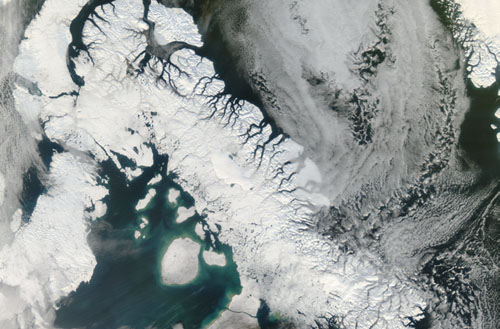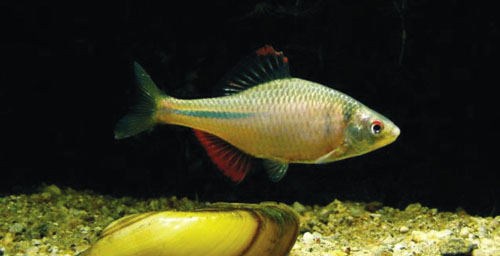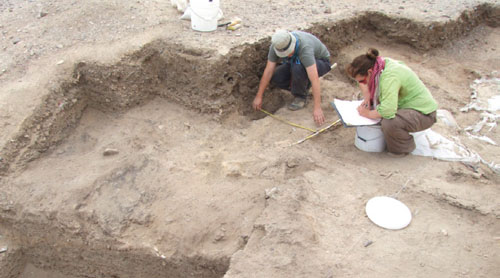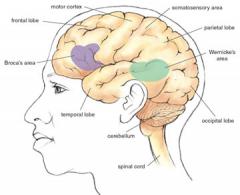
This Article From Issue
May-June 2012
Volume 100, Number 3
Page 205
DOI: 10.1511/2012.96.205
In this roundup, Elsa Youngsteadt summarizes some notable recent items about scientific research, selected from news reports compiled in Sigma Xi’s free electronic newsletters.
Birth of the Little Ice Age
Scientists have been uncertain about the specific timing and causes of Europe’s Little Ice Age (LIA), a chilly period that started sometime during the Renaissance and lasted until the mid-19th century. To better document the LIA’s onset, researchers analyzed 94 samples of ancient moss, previously engulfed by ice caps and recently exposed by melting, on Canada’s Baffin Island (pictured at right). The plants must have died when ice first entombed them, so the radiocarbon dates of their remains define periods of past ice expansion. A spike in moss casualties between 1275 and 1300 provides the most precise date yet for the beginning of the LIA cooling. That interval corresponds to four volcanic eruptions that, together, may have precipitated the centuries of cold weather.

Image courtesy of NASA.
Miller, G. H., et al. Abrupt onset of the Little Ice Age triggered by volcanism and sustained by sea-ice/ocean feedbacks. Geophysical Research Letters 39:L02708 (January 31)
Parasitism Upended
In Asia, the relationship between bitterling fish and unionid mussels goes back millions of years. The fish lay eggs in the mussels, whose own larvae parasitize the fish. Each partner evolved to cope with the other. But when one bitterling (Rhodeus amarus, pictured below) expanded its range in the 1800s, it began to lay eggs in Europe’s naive mussels—which are themselves unable to parasitize bitterlings. Score one for the fish. But in the 1970s, an Asian mussel (Anodonta woodiana) began its own westward invasion and turned the tables. It parasitizes R. amarus but makes a lousy host: In 30 experimental pools, R. amarus eggs never developed in A. woodiana mussels. During its time in Europe, the authors suggest, the fish may have lost adaptations that helped it parasitize Asian mussels.

Photograph courtesy of Carl Smith.
Reichard, M., et al. An invasive species reverses the roles in a host-parasite relationship between bitterling fish and unionid mussels. Biology Letters (published online February 15)
Isolated from Nature?
Children learn about society’s values in many ways, including reading kids’ books. A group of sociologists wondered how urbanization and environmentalism have shaped the messages conveyed in U.S. children’s literature. They examined more than 8,000 images in 296 books that received Caldecott recognition for outstanding illustrations between 1938 and 2008. Starting in the 1960s, pictures of built environments (such as houses) became more common, while those of natural environments (such as forests) became rare. By 2008, illustrations were more than twice as likely to show artificial settings than natural ones. The authors suggest that urbanization has the upper hand and that today’s children may not learn to appreciate the natural world—at least not from their award-winning books.
Williams, J. A., Jr., et al. The human-environment dialog in award-winning children’s picture books. Sociological Inquiry 82:145–159 (February)
Exercise Epigenetics
Some stretches of DNA are littered with methyl groups—chemical tags that, without changing the DNA sequence, prevent expression of nearby genes. These epigenetic modifications are often inherited and fairly permanent. But not always: Exercise, it turns out, leads to immediate, reversible changes to DNA methylation in muscle cells. In a new study, 14 sedentary young men and women exercised to fatigue on a stationary bike. Researchers collected thigh-muscle biopsies before and 20 minutes after the session. They found that five genes involved in energy metabolism (but not three other genes) lost a significant proportion of their methyl tags during or shortly after exertion. The change was correlated with increased expression of those genes. But even after a three-week exercise program, methylation returned to baseline with just two days of rest. The results are among the first to show a dynamic, short-term role for methylation in regulating gene function.
Barrès, R., et al. Acute exercise remodels promoter methylation in human skeletal muscle. Cell Metabolism 15:405–411 (March 7)
Stone Age Architecture
By 14,500 years ago, well before the dawn of agriculture, hunter-gatherers in the eastern Mediterranean gave up their migratory lifestyle and settled in villages. That transition was not, however, abrupt: New excavations in Jordan add to evidence that it had already begun 5,000 years earlier. Working at a site called Khareneh IV (pictured at right), archaeologists uncovered the remains of two Late Stone Age huts—oval, clay-floored structures of about 7 square meters. One floor was covered with a layer of charcoal, likely the remains of its walls and roof. Both dwellings held caches of potentially symbolic objects, including burnt gazelle horns, pierced seashells and lumps of red pigment. The huts and the density of artifacts suggest that the site was regularly occupied for months on end as multiple groups converged there, perhaps to socialize and hunt gazelles. (Photograph courtesy of EFAP Archive.)

Photograph courtesy of EFAP Archive.
Maher, L. A., et al. Twenty-thousand-year-old huts at a hunter-gatherer settlement in eastern Jordan. PLoS ONE 7:e31447 (February 15)

American Scientist Comments and Discussion
To discuss our articles or comment on them, please share them and tag American Scientist on social media platforms. Here are links to our profiles on Twitter, Facebook, and LinkedIn.
If we re-share your post, we will moderate comments/discussion following our comments policy.